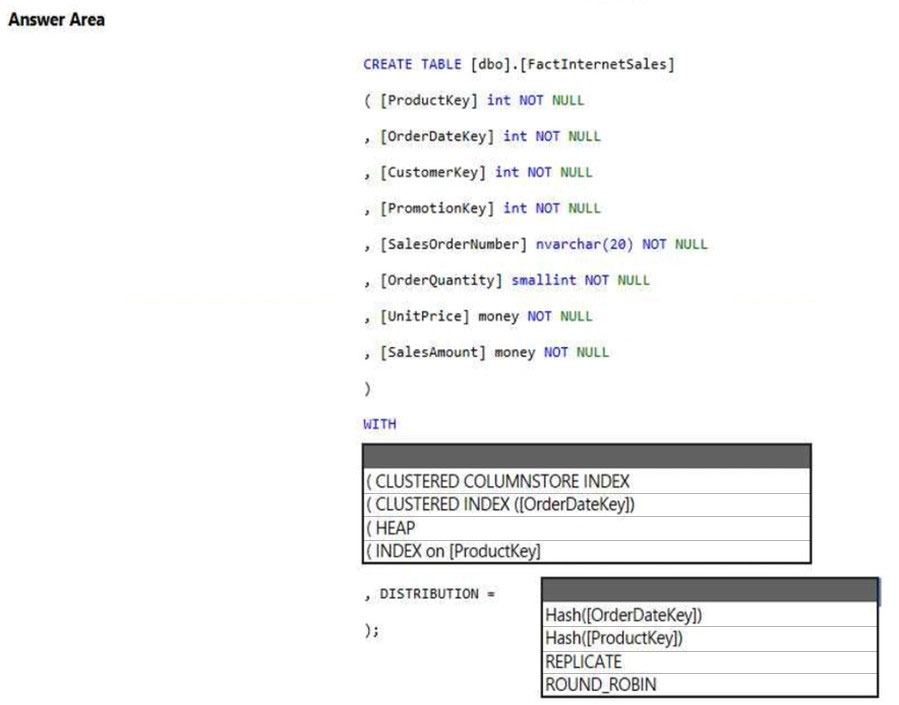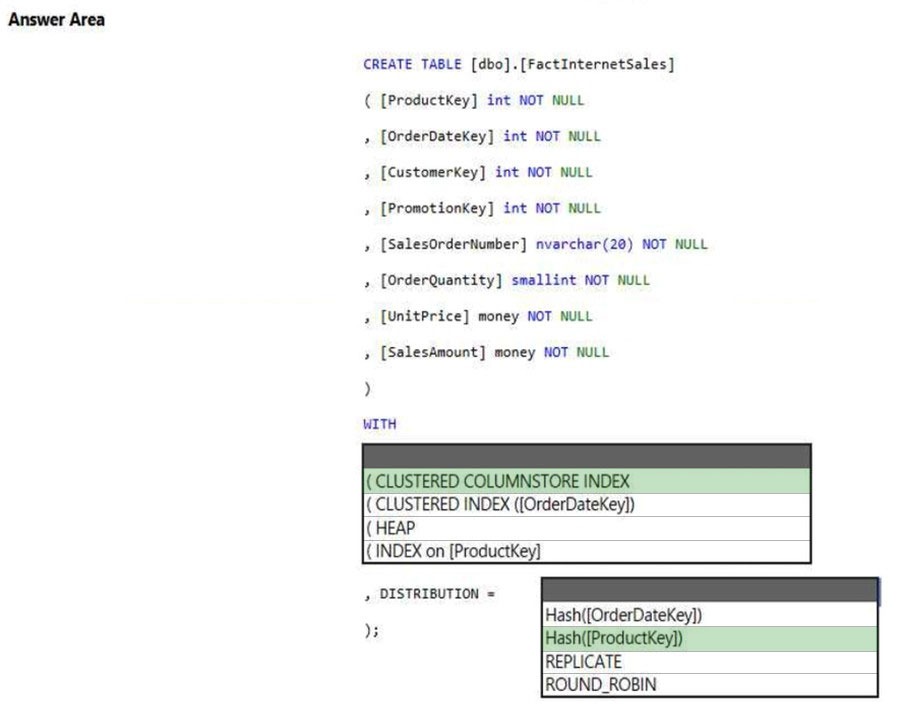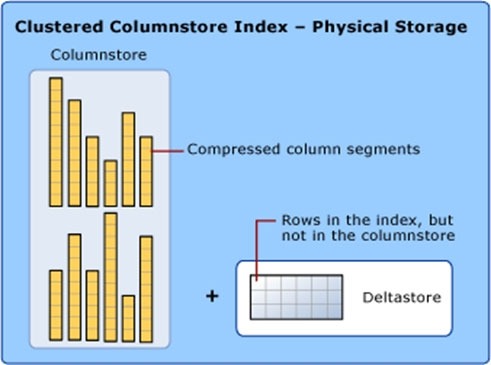Question #61
HOTSPOT –
You have an Azure Synapse Analytics dedicated SQL pool.
You need to create a table named FactInternetSales that will be a large fact table in a dimensional model. FactInternetSales will contain 100 million rows and two columns named SalesAmount and OrderQuantity. Queries executed on FactInternetSales will aggregate the values in SalesAmount and OrderQuantity from the last year for a specific product. The solution must minimize the data size and query execution time.
How should you complete the code? To answer, select the appropriate options in the answer area.
NOTE: Each correct selection is worth one point.
Hot Area:
Correct Answer:
Box 1: (CLUSTERED COLUMNSTORE INDEX
CLUSTERED COLUMNSTORE INDEX –
Columnstore indexes are the standard for storing and querying large data warehousing fact tables. This index uses column-based data storage and query processing to achieve gains up to 10 times the query performance in your data warehouse over traditional row-oriented storage. You can also achieve gains up to
10 times the data compression over the uncompressed data size. Beginning with SQL Server 2016 (13.x) SP1, columnstore indexes enable operational analytics: the ability to run performant real-time analytics on a transactional workload.
Note: Clustered columnstore index
A clustered columnstore index is the physical storage for the entire table.
To reduce fragmentation of the column segments and improve performance, the columnstore index might store some data temporarily into a clustered index called a deltastore and a B-tree list of IDs for deleted rows. The deltastore operations are handled behind the scenes. To return the correct query results, the clustered columnstore index combines query results from both the columnstore and the deltastore.
Box 2: HASH([ProductKey])
A hash distributed table distributes rows based on the value in the distribution column. A hash distributed table is designed to achieve high performance for queries on large tables.
Choose a distribution column with data that distributes evenly
Incorrect:
* Not HASH([OrderDateKey]). Is not a date column. All data for the same date lands in the same distribution. If several users are all filtering on the same date, then only 1 of the 60 distributions do all the processing work
* A replicated table has a full copy of the table available on every Compute node. Queries run fast on replicated tables since joins on replicated tables don’t require data movement. Replication requires extra storage, though, and isn’t practical for large tables.
* A round-robin table distributes table rows evenly across all distributions. The rows are distributed randomly. Loading data into a round-robin table is fast. Keep in mind that queries can require more data movement than the other distribution methods.
Reference:
https://docs.microsoft.com/en-us/sql/relational-databases/indexes/columnstore-indexes-overview https://docs.microsoft.com/en-us/azure/synapse-analytics/sql-data-warehouse/sql-data-warehouse-tables-overview https://docs.microsoft.com/en-us/azure/synapse-analytics/sql-data-warehouse/sql-data-warehouse-tables-distribute
Question #62
You have an Azure Synapse Analytics dedicated SQL pool that contains a table named Table1. Table1 contains the following:
✑ One billion rows
✑ A clustered columnstore index
✑ A hash-distributed column named Product Key
✑ A column named Sales Date that is of the date data type and cannot be null
Thirty million rows will be added to Table1 each month.
You need to partition Table1 based on the Sales Date column. The solution must optimize query performance and data loading.
How often should you create a partition?
- A. once per month
- B. once per year
- C. once per day
- D. once per week
Correct Answer: B
Need a minimum 1 million rows per distribution. Each table is 60 distributions. 30 millions rows is added each month. Need 2 months to get a minimum of 1 million rows per distribution in a new partition.
Note: When creating partitions on clustered columnstore tables, it is important to consider how many rows belong to each partition. For optimal compression and performance of clustered columnstore tables, a minimum of 1 million rows per distribution and partition is needed. Before partitions are created, dedicated SQL pool already divides each table into 60 distributions.
Any partitioning added to a table is in addition to the distributions created behind the scenes. Using this example, if the sales fact table contained 36 monthly partitions, and given that a dedicated SQL pool has 60 distributions, then the sales fact table should contain 60 million rows per month, or 2.1 billion rows when all months are populated. If a table contains fewer than the recommended minimum number of rows per partition, consider using fewer partitions in order to increase the number of rows per partition.
Reference:
https://docs.microsoft.com/en-us/azure/synapse-analytics/sql-data-warehouse/sql-data-warehouse-tables-partition
Question #63
You have an Azure Databricks workspace that contains a Delta Lake dimension table named Table1.
Table1 is a Type 2 slowly changing dimension (SCD) table.
You need to apply updates from a source table to Table1.
Which Apache Spark SQL operation should you use?
- A. CREATE
- B. UPDATE
- C. ALTER
- D. MERGE Most Voted
Correct Answer: D
The Delta provides the ability to infer the schema for data input which further reduces the effort required in managing the schema changes. The Slowly Changing
Data(SCD) Type 2 records all the changes made to each key in the dimensional table. These operations require updating the existing rows to mark the previous values of the keys as old and then inserting new rows as the latest values. Also, Given a source table with the updates and the target table with dimensional data,
SCD Type 2 can be expressed with the merge.
Example:
// Implementing SCD Type 2 operation using merge function
customersTable
.as(“customers”)
.merge(
stagedUpdates.as(“staged_updates”),
“customers.customerId = mergeKey”)
.whenMatched(“customers.current = true AND customers.address staged_updates.address”)
.updateExpr(Map(
“current” -> “false”,
“endDate” -> “staged_updates.effectiveDate”))
.whenNotMatched()
.insertExpr(Map(
“customerid” -> “staged_updates.customerId”,
“address” -> “staged_updates.address”,
“current” -> “true”,
“effectiveDate” -> “staged_updates.effectiveDate”,
“endDate” -> “null”))
.execute()
}
Reference:
https://www.projectpro.io/recipes/what-is-slowly-changing-data-scd-type-2-operation-delta-table-databricks
D (100%)
Question #64
You are designing an Azure Data Lake Storage solution that will transform raw JSON files for use in an analytical workload.
You need to recommend a format for the transformed files. The solution must meet the following requirements:
✑ Contain information about the data types of each column in the files.
✑ Support querying a subset of columns in the files.
✑ Support read-heavy analytical workloads.
✑ Minimize the file size.
What should you recommend?
- A. JSON
- B. CSV
- C. Apache Avro
- D. Apache Parquet
Correct Answer: D
Parquet, an open-source file format for Hadoop, stores nested data structures in a flat columnar format.
Compared to a traditional approach where data is stored in a row-oriented approach, Parquet file format is more efficient in terms of storage and performance.
It is especially good for queries that read particular columns from a ג€wideג€ (with many columns) table since only needed columns are read, and IO is minimized.
Incorrect:
Not C:
The Avro format is the ideal candidate for storing data in a data lake landing zone because:
1. Data from the landing zone is usually read as a whole for further processing by downstream systems (the row-based format is more efficient in this case).
2. Downstream systems can easily retrieve table schemas from Avro files (there is no need to store the schemas separately in an external meta store).
3. Any source schema change is easily handled (schema evolution).
Reference:
https://www.clairvoyant.ai/blog/big-data-file-formats
Question #65
Note: This question is part of a series of questions that present the same scenario. Each question in the series contains a unique solution that might meet the stated goals. Some question sets might have more than one correct solution, while others might not have a correct solution.
After you answer a question in this section, you will NOT be able to return to it. As a result, these questions will not appear in the review screen.
You have an Azure Storage account that contains 100 GB of files. The files contain rows of text and numerical values. 75% of the rows contain description data that has an average length of 1.1 MB.
You plan to copy the data from the storage account to an enterprise data warehouse in Azure Synapse Analytics.
You need to prepare the files to ensure that the data copies quickly.
Solution: You modify the files to ensure that each row is less than 1 MB.
Does this meet the goal?
- A. Yes
- B. No
Correct Answer:A
Polybase loads rows that are smaller than 1 MB.
Note on Polybase Load: PolyBase is a technology that accesses external data stored in Azure Blob storage or Azure Data Lake Store via the T-SQL language.
Extract, Load, and Transform (ELT)
Extract, Load, and Transform (ELT) is a process by which data is extracted from a source system, loaded into a data warehouse, and then transformed.
The basic steps for implementing a PolyBase ELT for dedicated SQL pool are:
Extract the source data into text files.
Land the data into Azure Blob storage or Azure Data Lake Store.
Prepare the data for loading.
Load the data into dedicated SQL pool staging tables using PolyBase.
Transform the data.
Insert the data into production tables.
Reference:
https://docs.microsoft.com/en-us/azure/synapse-analytics/sql-data-warehouse/sql-data-warehouse-service-capacity-limits https://docs.microsoft.com/en-us/azure/synapse-analytics/sql/load-data-overview
A (80%)
B (20%)
Question #66
You plan to create a dimension table in Azure Synapse Analytics that will be less than 1 GB.
You need to create the table to meet the following requirements:
✑ Provide the fastest query time.
✑ Minimize data movement during queries.
Which type of table should you use?
- A. replicated
- B. hash distributed
- C. heap
- D. round-robin
Correct Answer: A
A replicated table has a full copy of the table accessible on each Compute node. Replicating a table removes the need to transfer data among Compute nodes before a join or aggregation. Since the table has multiple copies, replicated tables work best when the table size is less than 2 GB compressed. 2 GB is not a hard limit.
Reference:
https://docs.microsoft.com/en-us/azure/synapse-analytics/sql-data-warehouse/design-guidance-for-replicated-tables
A (100%)
Question #67
You are designing a dimension table in an Azure Synapse Analytics dedicated SQL pool.
You need to create a surrogate key for the table. The solution must provide the fastest query performance.
What should you use for the surrogate key?
- A. a GUID column
- B. a sequence object
- C. an IDENTITY column
Correct Answer: C
Use IDENTITY to create surrogate keys using dedicated SQL pool in AzureSynapse Analytics.
Note: A surrogate key on a table is a column with a unique identifier for each row. The key is not generated from the table data. Data modelers like to create surrogate keys on their tables when they design data warehouse models. You can use the IDENTITY property to achieve this goal simply and effectively without affecting load performance.
Reference:
https://docs.microsoft.com/en-us/azure/synapse-analytics/sql-data-warehouse/sql-data-warehouse-tables-identity
C (100%)





